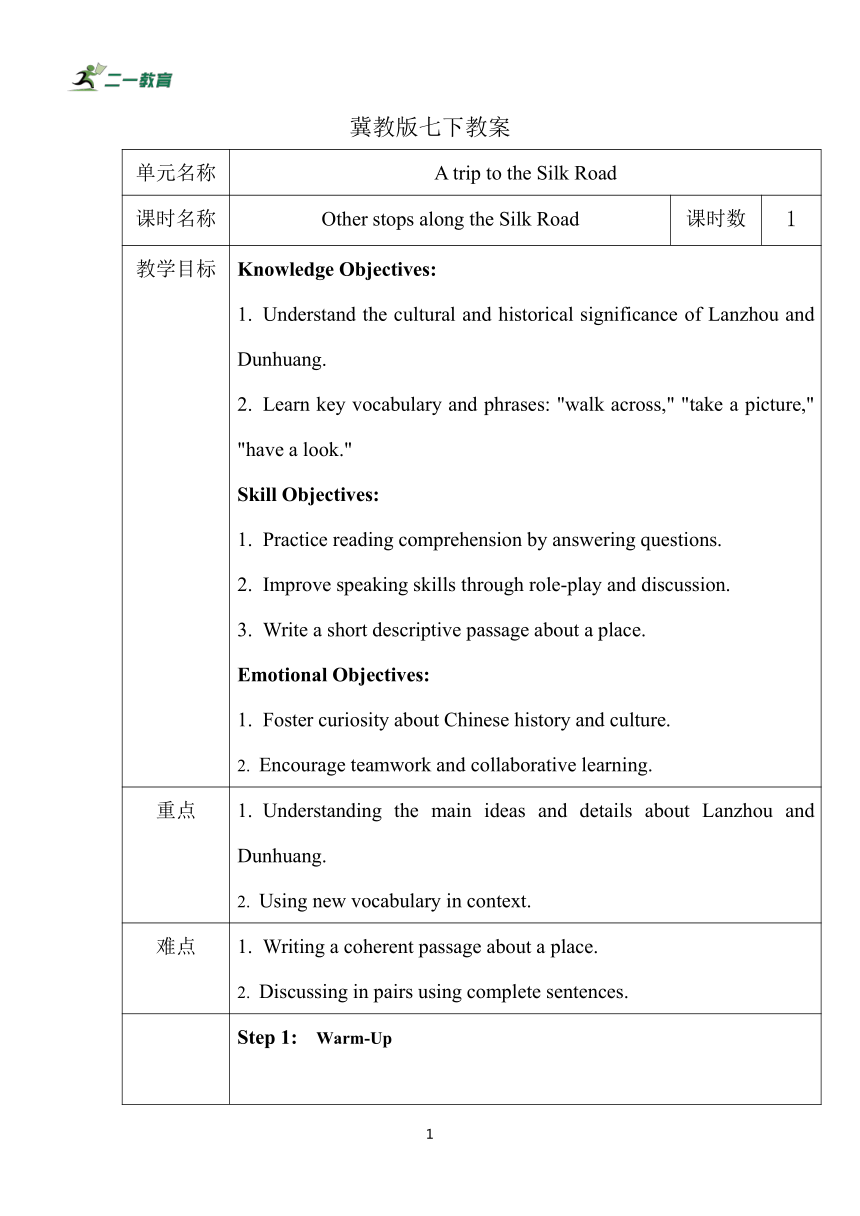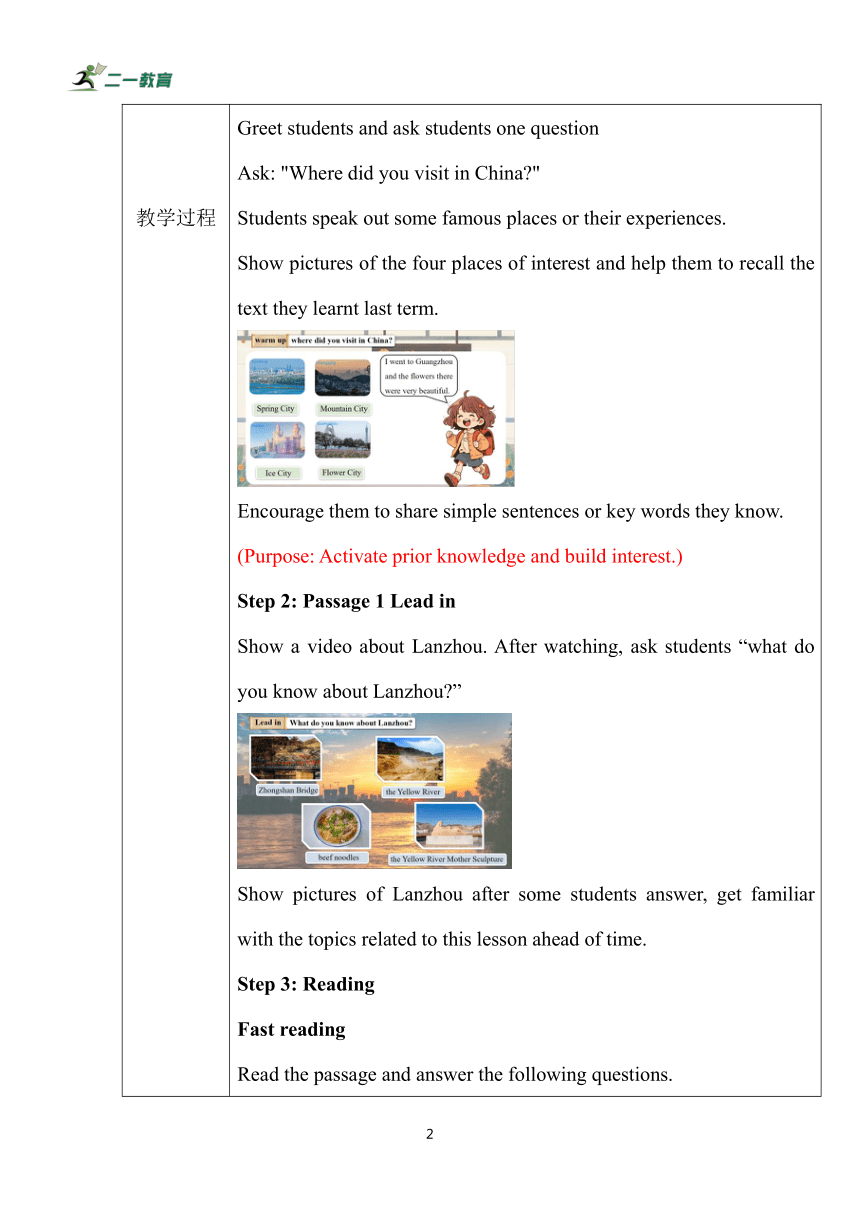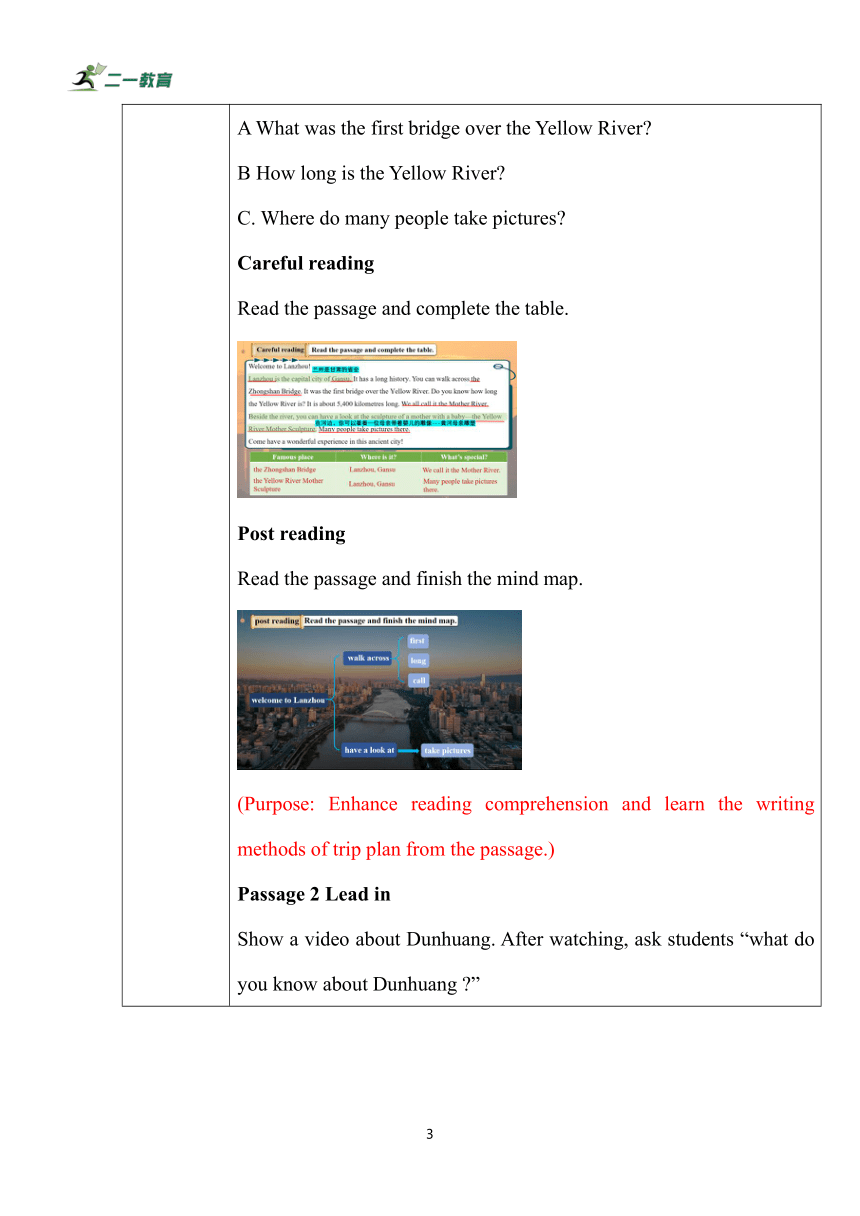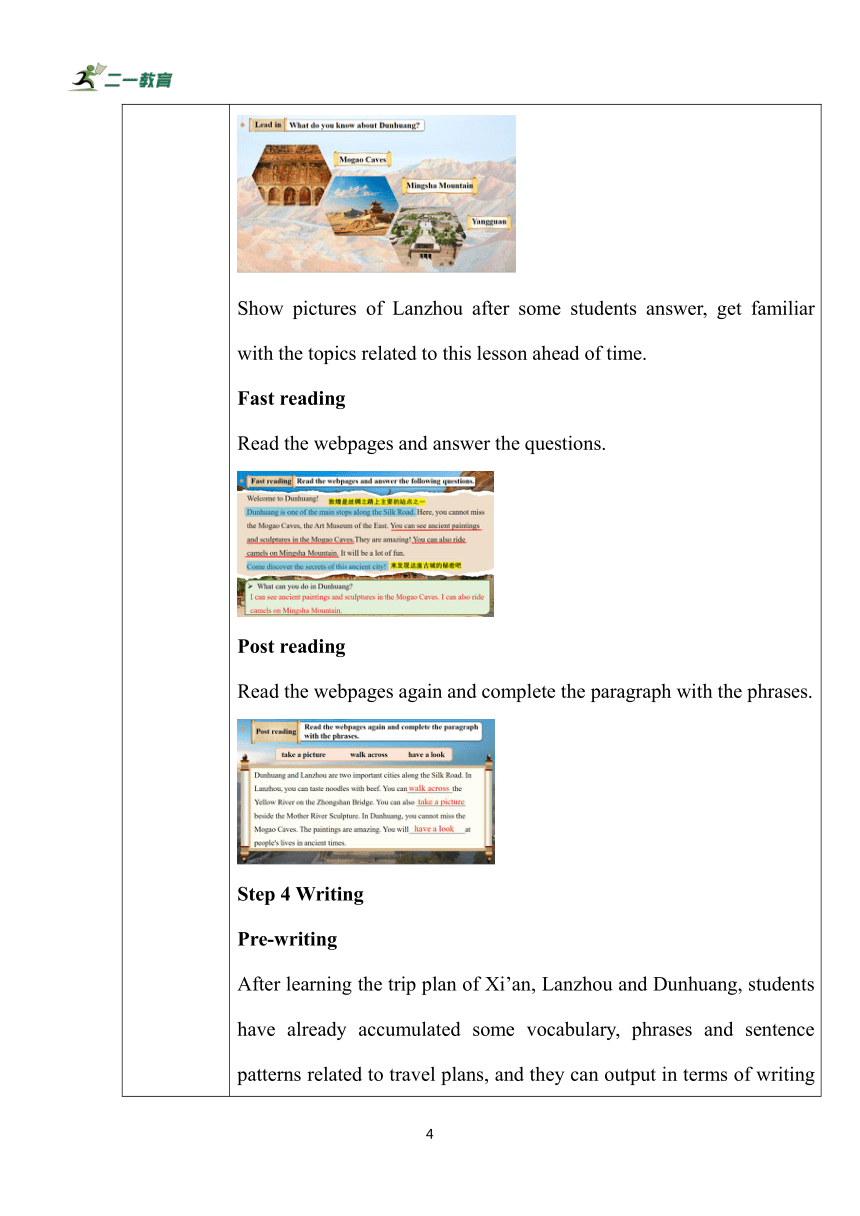Unit 1 Lesson 4 Other stops along the Silk Road教案
文档属性
| 名称 | Unit 1 Lesson 4 Other stops along the Silk Road教案 |  | |
| 格式 | docx | ||
| 文件大小 | 2.4MB | ||
| 资源类型 | 试卷 | ||
| 版本资源 | 冀教版 | ||
| 科目 | 英语 | ||
| 更新时间 | 2025-01-20 11:25:38 | ||
图片预览




文档简介
冀教版七下教案
单元名称 A trip to the Silk Road
课时名称 Other stops along the Silk Road 课时数 1
教学目标 Knowledge Objectives: Understand the cultural and historical significance of Lanzhou and Dunhuang. Learn key vocabulary and phrases: "walk across," "take a picture," "have a look." Skill Objectives: Practice reading comprehension by answering questions. Improve speaking skills through role-play and discussion. Write a short descriptive passage about a place. Emotional Objectives: Foster curiosity about Chinese history and culture. Encourage teamwork and collaborative learning.
重点 Understanding the main ideas and details about Lanzhou and Dunhuang. Using new vocabulary in context.
难点 Writing a coherent passage about a place. Discussing in pairs using complete sentences.
教学过程 Step 1: Warm-Up Greet students and ask students one question Ask: "Where did you visit in China " Students speak out some famous places or their experiences. Show pictures of the four places of interest and help them to recall the text they learnt last term. Encourage them to share simple sentences or key words they know. (Purpose: Activate prior knowledge and build interest.) Step 2: Passage 1 Lead in Show a video about Lanzhou. After watching, ask students “what do you know about Lanzhou ” Show pictures of Lanzhou after some students answer, get familiar with the topics related to this lesson ahead of time. Step 3: Reading Fast reading Read the passage and answer the following questions. A What was the first bridge over the Yellow River B How long is the Yellow River C. Where do many people take pictures Careful reading Read the passage and complete the table. Post reading Read the passage and finish the mind map. (Purpose: Enhance reading comprehension and learn the writing methods of trip plan from the passage.) Passage 2 Lead in Show a video about Dunhuang. After watching, ask students “what do you know about Dunhuang ” Show pictures of Lanzhou after some students answer, get familiar with the topics related to this lesson ahead of time. Fast reading Read the webpages and answer the questions. Post reading Read the webpages again and complete the paragraph with the phrases. Step 4 Writing Pre-writing After learning the trip plan of Xi’an, Lanzhou and Dunhuang, students have already accumulated some vocabulary, phrases and sentence patterns related to travel plans, and they can output in terms of writing according to the knowledge they have learned. Create a scenario for students to apply their learned knowledge to solve a real - world problem: "Suppose Danny and Jenny are coming for a trip. Please design a travel plan for them." (Purpose: With the help of some picture hints on the PPT and by inspiring students' previously learned knowledge, they can quickly complete the form and activate the known topics.) While-writing Students finish their own writing according to the chart. Post-writing Four students a group and give them 5 minutes to prepare the passage. Choose a leader to share their articles. (Purpose: Enhance speaking skills and boost confidence in using English in real-life contexts.) Step 5 Language points Step 6 Exercises Finish the exercises on PPT. Step 7 Homework Basic assignments:
Find out the relevant sentences about the description of scenic spots in the text and organize them in your notebook. Practical assignments:
Write a short passage to introduce a city or a scenic spot you have been to. Use at least 3 learned words or phrases and the passage should be no less than 50 words. Expansion assignments:
Look up information and find out two famous historical and cultural cities in China. Then briefly introduce one of their famous scenic spots in English. The introduction should consist of no less than 5 sentences.
板书设计
教学反思 What Worked Well: Students were engaged in role-play and enjoyed practicing vocabulary in pairs. The map helped students visualize the locations. What to Improve: Allocate more time for writing practice. Prepare additional questions for faster learners.
单元名称 A trip to the Silk Road
课时名称 Other stops along the Silk Road 课时数 1
教学目标 Knowledge Objectives: Understand the cultural and historical significance of Lanzhou and Dunhuang. Learn key vocabulary and phrases: "walk across," "take a picture," "have a look." Skill Objectives: Practice reading comprehension by answering questions. Improve speaking skills through role-play and discussion. Write a short descriptive passage about a place. Emotional Objectives: Foster curiosity about Chinese history and culture. Encourage teamwork and collaborative learning.
重点 Understanding the main ideas and details about Lanzhou and Dunhuang. Using new vocabulary in context.
难点 Writing a coherent passage about a place. Discussing in pairs using complete sentences.
教学过程 Step 1: Warm-Up Greet students and ask students one question Ask: "Where did you visit in China " Students speak out some famous places or their experiences. Show pictures of the four places of interest and help them to recall the text they learnt last term. Encourage them to share simple sentences or key words they know. (Purpose: Activate prior knowledge and build interest.) Step 2: Passage 1 Lead in Show a video about Lanzhou. After watching, ask students “what do you know about Lanzhou ” Show pictures of Lanzhou after some students answer, get familiar with the topics related to this lesson ahead of time. Step 3: Reading Fast reading Read the passage and answer the following questions. A What was the first bridge over the Yellow River B How long is the Yellow River C. Where do many people take pictures Careful reading Read the passage and complete the table. Post reading Read the passage and finish the mind map. (Purpose: Enhance reading comprehension and learn the writing methods of trip plan from the passage.) Passage 2 Lead in Show a video about Dunhuang. After watching, ask students “what do you know about Dunhuang ” Show pictures of Lanzhou after some students answer, get familiar with the topics related to this lesson ahead of time. Fast reading Read the webpages and answer the questions. Post reading Read the webpages again and complete the paragraph with the phrases. Step 4 Writing Pre-writing After learning the trip plan of Xi’an, Lanzhou and Dunhuang, students have already accumulated some vocabulary, phrases and sentence patterns related to travel plans, and they can output in terms of writing according to the knowledge they have learned. Create a scenario for students to apply their learned knowledge to solve a real - world problem: "Suppose Danny and Jenny are coming for a trip. Please design a travel plan for them." (Purpose: With the help of some picture hints on the PPT and by inspiring students' previously learned knowledge, they can quickly complete the form and activate the known topics.) While-writing Students finish their own writing according to the chart. Post-writing Four students a group and give them 5 minutes to prepare the passage. Choose a leader to share their articles. (Purpose: Enhance speaking skills and boost confidence in using English in real-life contexts.) Step 5 Language points Step 6 Exercises Finish the exercises on PPT. Step 7 Homework Basic assignments:
Find out the relevant sentences about the description of scenic spots in the text and organize them in your notebook. Practical assignments:
Write a short passage to introduce a city or a scenic spot you have been to. Use at least 3 learned words or phrases and the passage should be no less than 50 words. Expansion assignments:
Look up information and find out two famous historical and cultural cities in China. Then briefly introduce one of their famous scenic spots in English. The introduction should consist of no less than 5 sentences.
板书设计
教学反思 What Worked Well: Students were engaged in role-play and enjoyed practicing vocabulary in pairs. The map helped students visualize the locations. What to Improve: Allocate more time for writing practice. Prepare additional questions for faster learners.
同课章节目录
